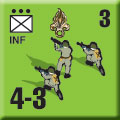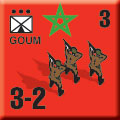La Campagne de Tunisie:
French Pieces, Part Four
by Mike Bennighof, Ph.D.
December 2022
 France’s military forces in North Africa drew their manpower from a variety of sources, including local Berbers and Arabs conscripted (in Algeria only) or inducted as volunteers, French colonists and French recruits from the Metropole. Some of the best-known “French” soldiers of the Army of Africa weren’t even French at all. They appear in Panzer Grenadier: La Campagne de Tunisie, an expansion for An Army at Dawn. Let’s take a look at them. France’s military forces in North Africa drew their manpower from a variety of sources, including local Berbers and Arabs conscripted (in Algeria only) or inducted as volunteers, French colonists and French recruits from the Metropole. Some of the best-known “French” soldiers of the Army of Africa weren’t even French at all. They appear in Panzer Grenadier: La Campagne de Tunisie, an expansion for An Army at Dawn. Let’s take a look at them.
The Foreign Legion
There’s no military formation more famous than the French Foreign Legion, celebrated for a century and a half as a refuge where scorned lovers, scoundrels, political dissidents and just plain adventurers found a place and a purpose fighting France’s enemies.
 For the 1940 campaign in France, the Legion formed three infantry regiments and a reconnaissance group. The Legion’s 13th Infantry Regiment (mostly recruited from left-wing Spaniards who had fled to France following the end of the Spanish Civil War) fought in Norway during the abortive Franco-British attempt to hold the port of Narvik, and afterwards most of its men chose to support the Gaullist Free French movement. The other two regiments and the recon group (the size of a small battalion, with horsed cavalry and motorcycle troops) remained under Vichy control after the Armistice. The new regime refused Nazi demands to hand over Jews and German, Austrian and Italian political opponents who had joined the Legion, posting them to a new 4th Foreign Legion Regiment soon dispatched to West Africa. For the 1940 campaign in France, the Legion formed three infantry regiments and a reconnaissance group. The Legion’s 13th Infantry Regiment (mostly recruited from left-wing Spaniards who had fled to France following the end of the Spanish Civil War) fought in Norway during the abortive Franco-British attempt to hold the port of Narvik, and afterwards most of its men chose to support the Gaullist Free French movement. The other two regiments and the recon group (the size of a small battalion, with horsed cavalry and motorcycle troops) remained under Vichy control after the Armistice. The new regime refused Nazi demands to hand over Jews and German, Austrian and Italian political opponents who had joined the Legion, posting them to a new 4th Foreign Legion Regiment soon dispatched to West Africa.
The Legion formed two infantry regiments in North Africa, with the 3rd Infantry in the Oran Division in Algeria and the 1st Infantry and 1st Cavalry (mostly a motorized unit) stationed in Morocco. Another Legion regiment went to Syria and saw action against the Allied invasion of 1941 (including combat against the 13th Regiment).
When American troops landed near Oran, the Legion’s 3rd Infantry received orders to march from the depot at Sidi-bel-Abbes to counter-attack them. The regiment’s command staff deliberately conducted a slow advance and did not attack when they made contact, instead waiting for formal notification that the Army of Africa would join the Allied side.
Reinforced by the anti-Nazi Germans of 4th Infantry Regiment, the two infantry regiments went to the front to fight the Axis. The 3rd Regiment fought alongside the Americans at Kasserine Pass, engaging the Germans in a bloody fight on the heights known as the Djebel Mansour. First Regiment fought with the British, while the Free French 13th Regiment saw action along the Mareth Line in southern Tunisia. Some German former Legionaries, serving in the German 361st Infantry Regiment, were captured after the Axis surrender; many asked to re-join the Legion but despite a lack of trained replacements these men were sent to prison camps instead and not allowed to enlist until after the end of the war.
Legion units of the Army of Africa were armed and organized according to the same tables as the regular army and had the same sub-standard weaponry and transports. After the fall of Tunis, they received new American battle dress, weapons and vehicles for the coming campaigns in Europe.
Goumiers
Soon after the French occupation of Morocco in 1908, the invaders began to recruit Algerian tribesmen as auxiliaries known as goumiers (from the Berber koum, or “people”). When they became sated with plunder and went home, the French recruited locals to take their place but still called them goumiers.
 Two hundred goumiers constituted a goum. Four goums made a tabor, and three tabors a groupement. The goumiers, officially in the service of the Sultan of Morocco though they were paid, equipped and officered directed by the French, didn’t go to France in 1914 along with the Moroccan regular regiments, which were elements of the French Army. They instead provided internal security, allowing the garrison to depart. Two hundred goumiers constituted a goum. Four goums made a tabor, and three tabors a groupement. The goumiers, officially in the service of the Sultan of Morocco though they were paid, equipped and officered directed by the French, didn’t go to France in 1914 along with the Moroccan regular regiments, which were elements of the French Army. They instead provided internal security, allowing the garrison to depart.
The goumiers proved to be effective light infantry, fighting in a counter-insurgency role against Moroccan dissidents, particularly during the Rif War of the 1920’s. Though armed by the French with modern small arms, they preferred their long knives and wore their distinctive brown-and-gray stripped cloaks rather than French uniforms.
When World War Two broke out, the French formed a groupement for service along the border between Tunisia and Libya, and withdrew it to Morocco after the Armistice. The French insisted that the goumiers served the Sultan and therefore should not count against the numerical limits placed on the Army of Africa. The Germans seem not to have cared, but under Italian pressure they ordered the French to disband one regiment of regulars to offset the goumier numbers.
 The Axis grossly under-estimated the number of goumiers kept under arms, which totaled about 20,000 men between 1940 and 1942. One groupement was dispatched to Tunisia to join the fighting against the Axis in December 1942, followed by a second a month later. In addition to light infantry, each tabor and groupement had a mounted platoon of scouts. Light mortar, machine gun and anti-tank platoons and an engineer section (a half-platoon) were manned by French or North African personnel. After the fall of Tunis the goumiers received American weaponry, including mortars and machine guns, but remained a light infantry organization without organic artillery. The Axis grossly under-estimated the number of goumiers kept under arms, which totaled about 20,000 men between 1940 and 1942. One groupement was dispatched to Tunisia to join the fighting against the Axis in December 1942, followed by a second a month later. In addition to light infantry, each tabor and groupement had a mounted platoon of scouts. Light mortar, machine gun and anti-tank platoons and an engineer section (a half-platoon) were manned by French or North African personnel. After the fall of Tunis the goumiers received American weaponry, including mortars and machine guns, but remained a light infantry organization without organic artillery.
Three groupements went to fight in Italy in late 1943 and early 1944, while another saw action in Corsica. They earned a reputation for excellent fighting skills in rough terrain and at night, and for committing possibly thousands of rapes, usually targeting women, children and Catholic priests. Nevertheless, they remained at the front until the Nazi surrender, fighting across France and into Germany.
All told, about 22,000 men served in goums (about 80 percent of them Moroccan tribesmen, and the rest Algerian or French non-commissioned and commissioned officers). They suffered 1,638 killed in action (including 166 officers), 7,500 wounded and four taken prisoner – a testimony to both their tenacity and their reputation for committing battlefield atrocities.
And those are the French Army of Africa’s non-French (or colonial) forces found in La Campagne de Tunisie. Next time, we’ll move on to the Germans.
You can order La Campagne de Tunisie right here.
Sign up for our newsletter right here. Your info will never be sold or transferred; we'll just use it to update you on new games and new offers.
Mike Bennighof is president of Avalanche Press and holds a doctorate in history from Emory University. A Fulbright Scholar and NASA Journalist in Space finalist, he has published a great many books, games and articles on historical subjects; people are saying that some of them are actually good.
He lives in Birmingham, Alabama with his wife and three children. He misses his Iron Dog, Leopold.
Want to keep Daily Content free of third-party ads? You can send us some love (and cash) through this link right here.
|
